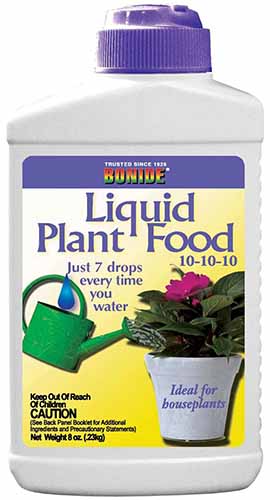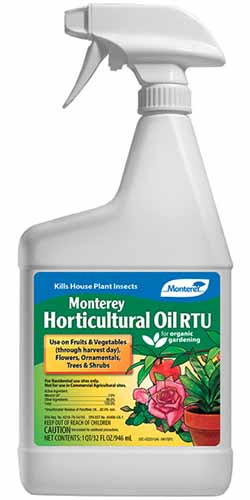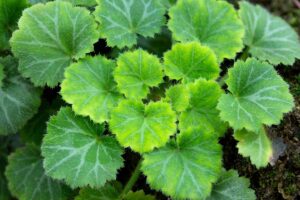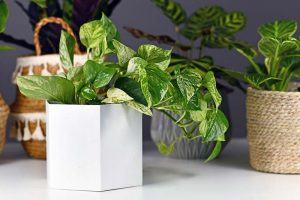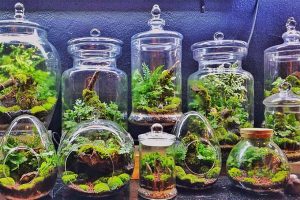Dioscorea elephantipes
In the houseplant growing game, it’s important to shake things up from time to time.
So if you’ve ever looked at your houseplants and thought enough with this leafy emphasis, time to show off a pretty stem for once, then might I suggest a tortoise plant?
Not that the leaves and flowers aren’t pretty – they absolutely are.
But the first thing about Dioscorea elephantipes that catches your eye is its massive, rounded, and plated stem, which definitely resembles a tortoise’s shell. Minus the vining shoots growing out the top, of course.
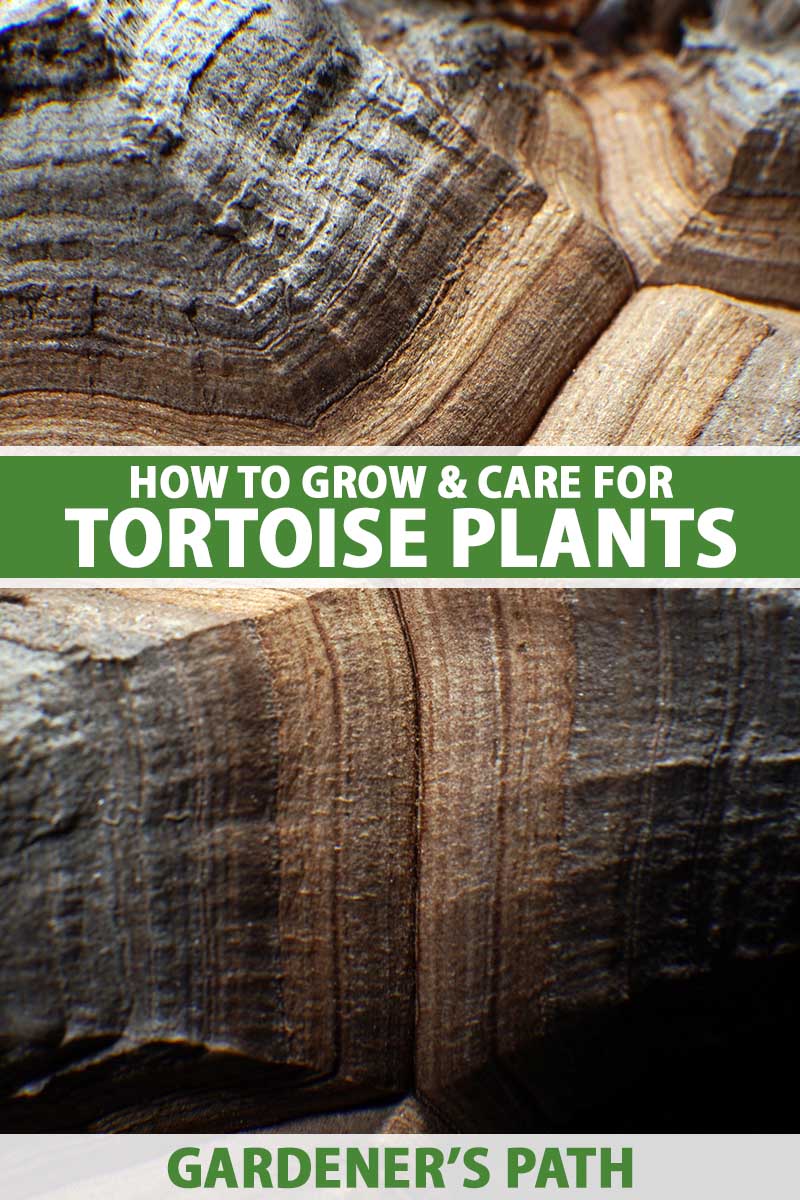
We link to vendors to help you find relevant products. If you buy from one of our links, we may earn a commission.
And just like with actual tortoises, proper care and nurturing is essential for tortoise plants to thrive.
As you can imagine, these guys are quite tough, but thriving – instead of merely surviving – is what’ll really make them beautiful.
So that’s why we whipped up this guide for you. By the end of it, you’ll have learned the wonderful secrets of tortoise plants, and you’ll be well-prepared to parent one in your home.
Here’s what we’ll cover:
What You’ll Learn
What Are Tortoise Plants?
Native to the Cape Province of South Africa, Dioscorea elephantipes belongs to the largest genus of the Dioscoreaceae family.
Containing over 600 species, the vast Dioscorea genus of flowering tuberous plants is distributed worldwide, with edible yams such as D. trifida and D. alata being its most famous and commercially valuable members.
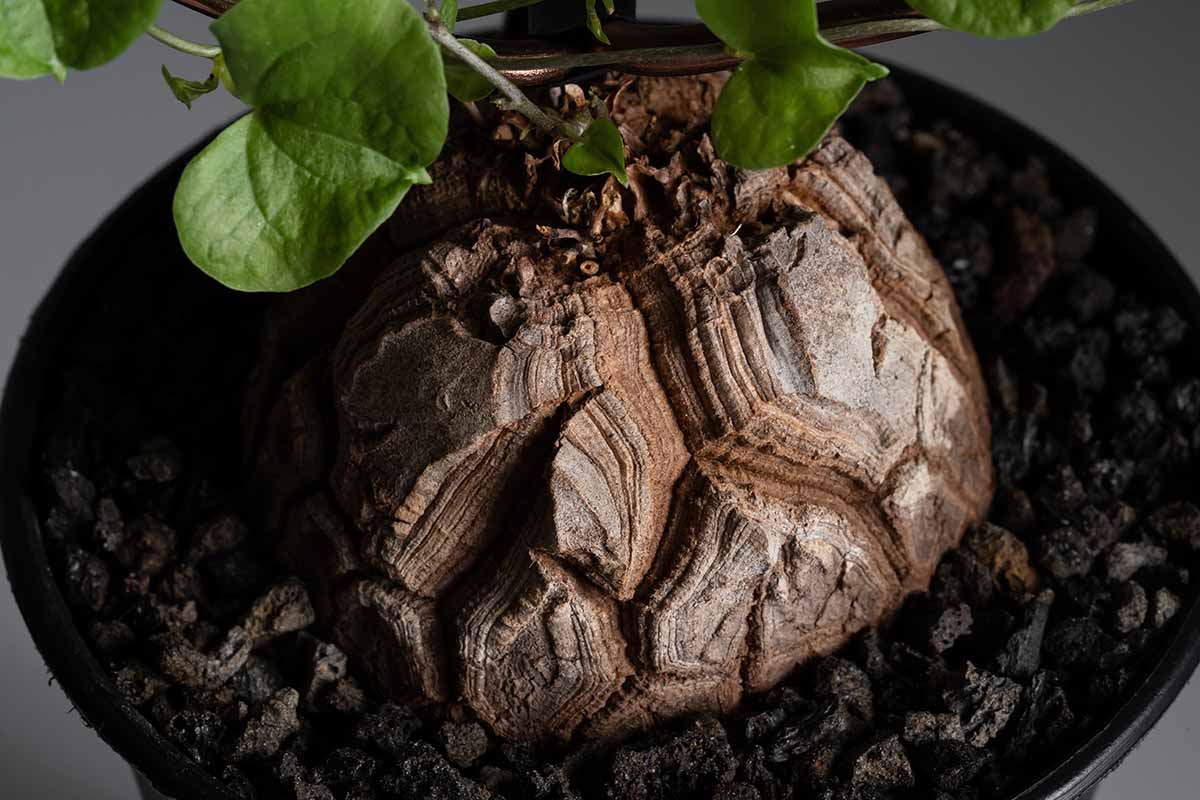
Hardy in USDA Zones 9b or warmer, the tortoise plant – aka elephant’s foot – has an enlarged, bulbous, aboveground stem known as a caudex, which provides support and stores water and nutrients.
I think this knobby, plated caudex predominantly looks like a tortoise shell, but its shape and gray color does resemble that of an elephant’s foot, I suppose.
From the top of the caudex grows climbing deciduous vines with green, heart-shaped leaves.
Caudex and leaves included, D. elephantipes reaches a mature height and spread of nine feet and seven feet, respectively.
But that’s in its native outdoor habitat – when grown indoors, it’s typically much smaller.
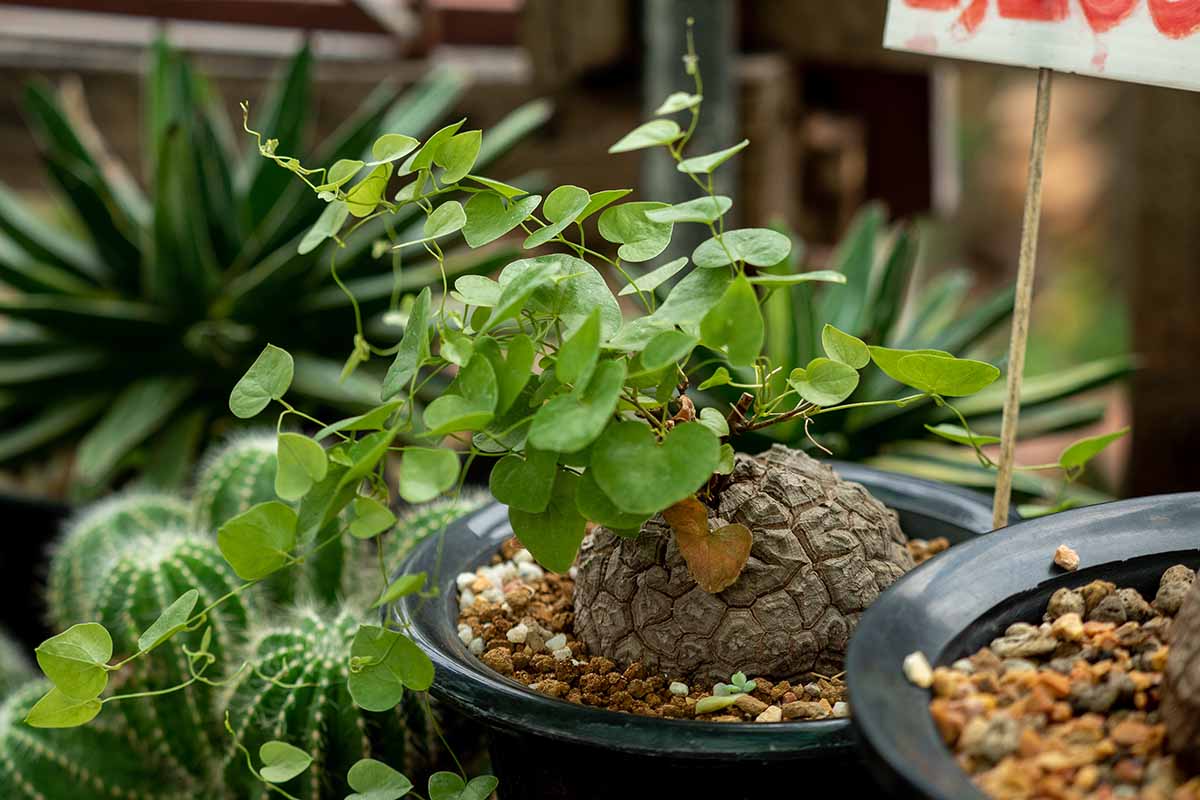
Another unique feature of the tortoise plant: its summer dormancy.
Since conditions can be so hot and dry in its native habitat, it has evolved to drop its leaves and undergo a dormancy period during the heat and drought of summertime.
So physiologically, it behaves in fall and winter like most other plants would during spring and summer! Although the exact dormancy period can vary a bit when grown indoors in the Northern Hemisphere.
After a minimum of ten years or so, the tortoise plant blooms in fall to winter with small racemes of white and/or yellow to green flowers.
As dioecious plants, both a male and a female are necessary to yield small seeds in spring, which are brown with a membranous, crinkled, and whitish “wing” on one end.
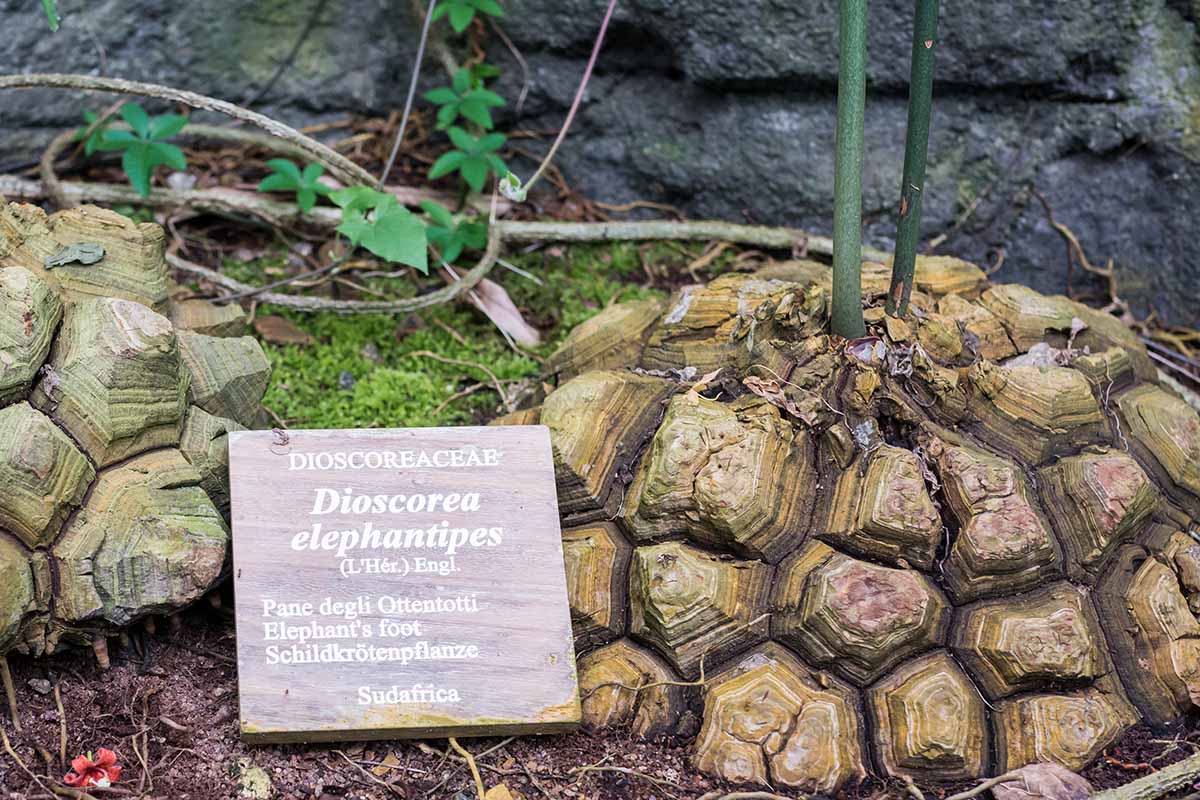
In the past, the caudexes of D. elephantipes were processed and baked by the Khoisan peoples of southern Africa to yield a bread-like food source.
But I wouldn’t go whipping up some tortoise plant bread or anything like that – tortoise plants contain high amounts of toxic saponins, which are chemical compounds often used for synthesizing corticosteroids and birth control. Not exactly stuff you should make toast with.
In ornamental gardening, the tortoise plant is used to add visual flair, both indoors as a houseplant and out in the landscape. It certainly does a swell job – it was awarded the Royal Horticultural Society’s prestigious Award of Garden Merit in 2002!
Tortoise Plant Propagation
If you want to propagate a tortoise plant of your own, you’ll need to either grow it from seed or transplant an established specimen.
Sowing Seeds
First things first: you need seeds. Order seeds online, acquire seeds from a friend, or pick dried seed capsules from accessible tortoise plants.
The ideal sowing time is fall, so plan your seed acquisition accordingly.

When you have your seeds, first remove the “wings.” Add a moisture-retaining yet well-draining growing media to a seed tray, then bury your seeds a third of an inch deep, spaced at least an inch apart.
Moisten the growing media, cover the tray with clear plastic or a humidity dome, then place the tray somewhere indoors where it’s exposed to bright, indirect sunlight.
For germination to occur, the seeds will need temperatures of 70 to 80°F.
A bottom heat pad is a great way to increase the soil temperature without having to heat the rest of your home. You can find seedling heat mats available in multiple different sizes at Gardener’s Supply Co.
Keep the media moist and the seedlings should germinate in two to three weeks. Once you notice sprouting above the soil line, remove the heat mat and covering, and continue to care for your seedlings by keeping the media moist.
After a year of growth, the seedlings should be ready to move into their own individual three- to four-inch containers, each filled with a media that leans more towards “well-draining” than “moisture-retentive.”
A tropical potting mix or soil suitable for cacti and succulents will be ideal.
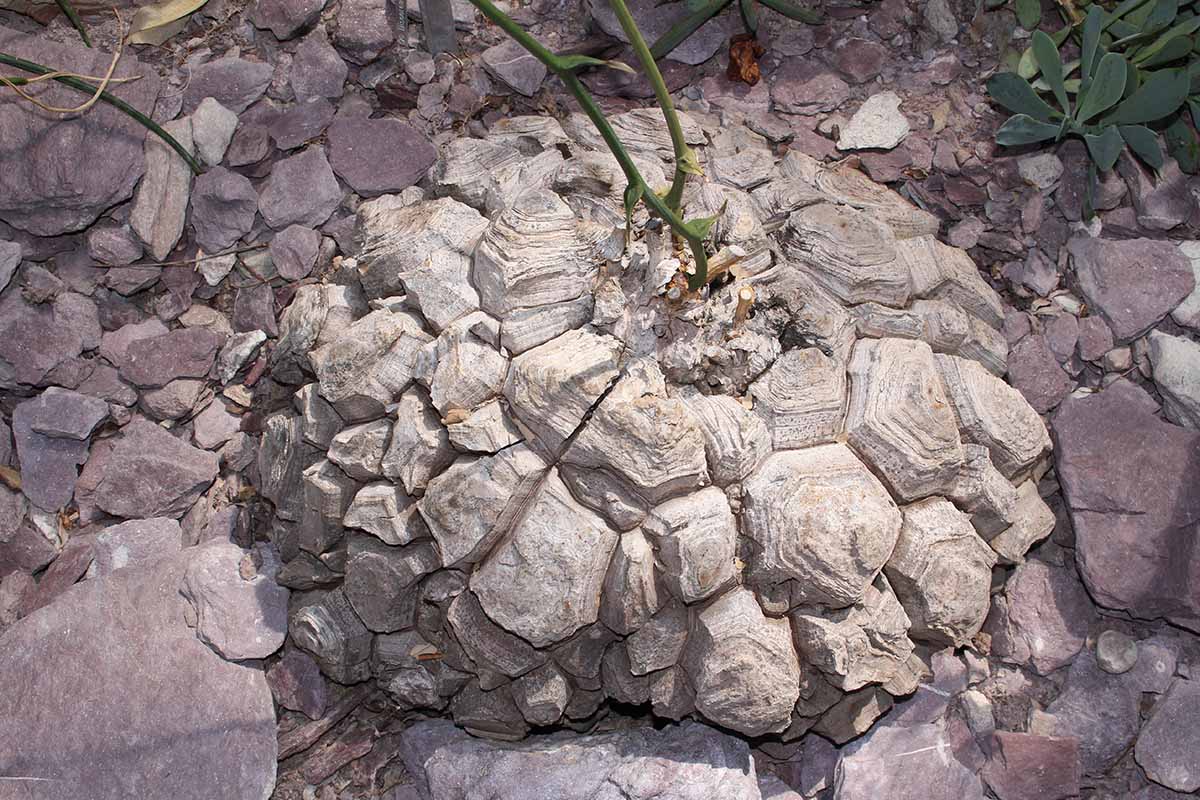
If you can, opt for terra cotta containers over plastic ones – they provide the aeration necessary for preventing excess moisture in the soil.
At this point, you’re free to treat the seedlings like you would an established specimen, albeit carefully.
Transplanting
Want to transplant a seedling or a new specimen into one of your swanky houseplant pots? Here’s how!
While your transplant still has its leaves and is actively growing, select your pot. The container should have drainage holes and be an inch or two wider than the diameter of the caudex.
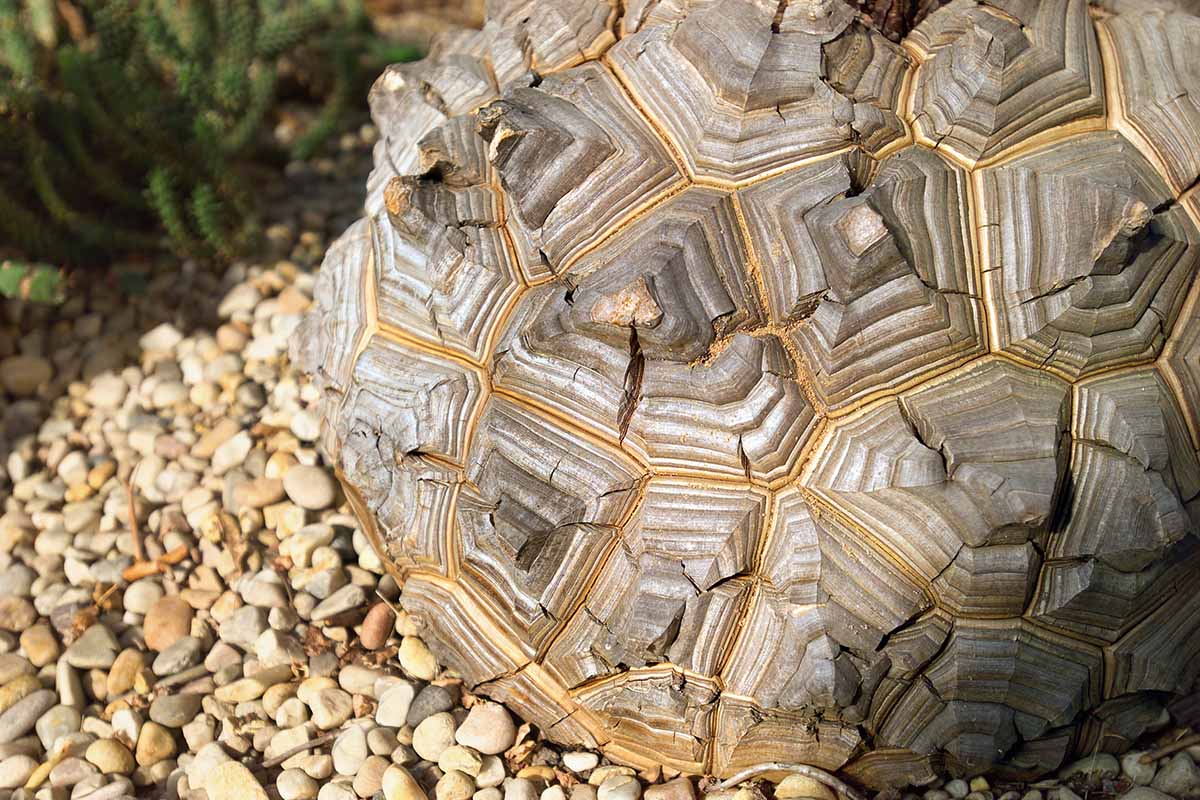
Fill it up to a bit below the brim with a potting medium fit for cacti, or perhaps a homemade mixture that’s comprised of one third sand, one third perlite, and one third peat moss or coconut coir.
Dig a hole in the media that’s large enough for the root system, add the transplant, backfill the soil up to the bottom of the caudex, and water in well.
How to Grow Tortoise Plants
Tortoise plants are durable enough to do alright without much coddling. But a bit of attention at the right time definitely helps them look their best.
Climate and Exposure Needs
D. elephantipes prefers heat, and can handle temperatures as high as 104°F and as low as 25°F. But don’t think you need to make your home’s climate like that of South Africa or anything.
The typical “room temperature” of most homes should do just fine.
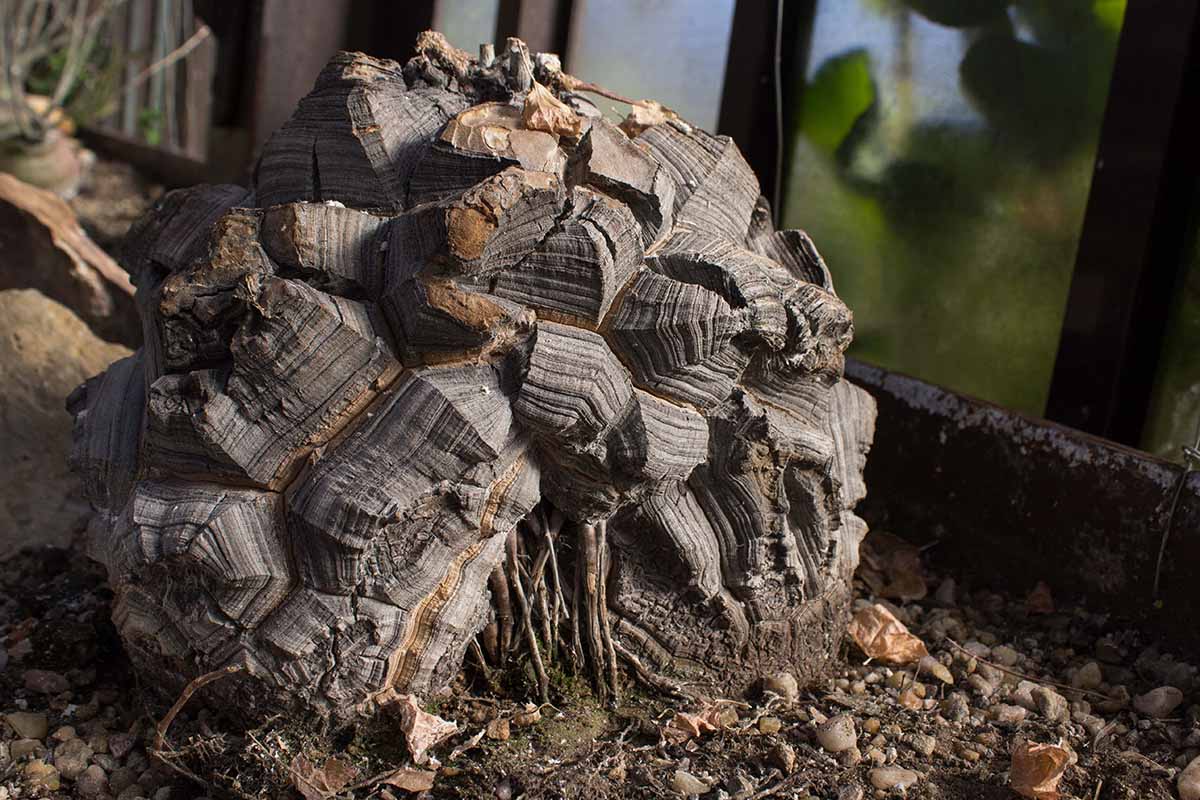
Its light requirements are pretty interesting: the vining stem, leaves, and flowers all prefer bright, direct sun, while the actual caudex prefers more indirect light, or even straight-up shade.
In nature, the shoots can grow tall and dense enough to block the sun from hitting much of the caudex, while indoor tortoise plant shoots don’t usually grow large enough for that.
The ideal indoor location would meet these requirements simultaneously, but sticking to this perfectly isn’t a must – just do the best you can.
Many indoor windows don’t go all the way down to the floor, so setting the tortoise plant flush against the wall beneath the window can illuminate the vines, yet block light from hitting the caudex.
Soil Needs
In its natural habitat, tortoise plants thrive in organically-rich, sandy loam.
For indoor growers, as mentioned above, a potting mix suitable for cacti will do the job, ideally with a pH of 5.5 to 6.5.

Need a product recommendation? Try this quick-draining potting mix from Miracle-Gro, available in eight-quart volumes from Amazon.
Water and Fertilizer Needs
Once a D. elephantipes is established and beyond the young seedling stage, its moisture needs become much less liberal.
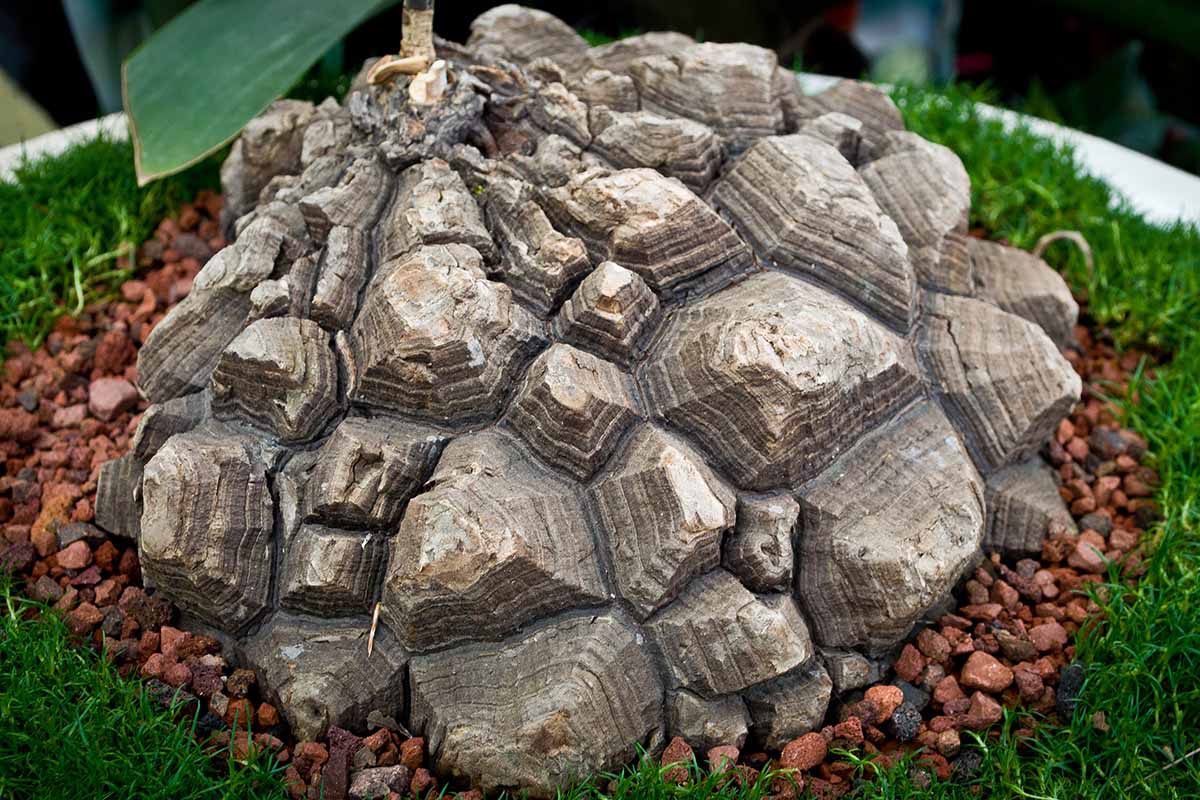
In the case of an established tortoise plant, instead of keeping the media consistently moist, you’ll want to let it dry out completely before you irrigate again.
When the leaves have dropped during dormancy, the soil will take longer to dry out than it would during the growing season.
Once-a-month fertilizations diluted down to quarter-strength will help provide the necessary nutrition. No need to fertilize during spring and summer dormancy, though.
Need some fertilizer? Check out Bonide’s liquid 10-10-10 fertilizer, available in eight-ounce volumes at Walmart.
Growing Tips
- The vegetative shoots like full sun, while the corky caudex appreciates partial to full shade.
- A growing media with ample drainage is essential.
- Allow the media to dry out completely in between waterings.
Pruning and Maintenance
Dead, damaged, or sickly vines should be pruned away as you notice them, along with spent flowers. You should also cut down the vines during the tortoise plant’s dormancy period.
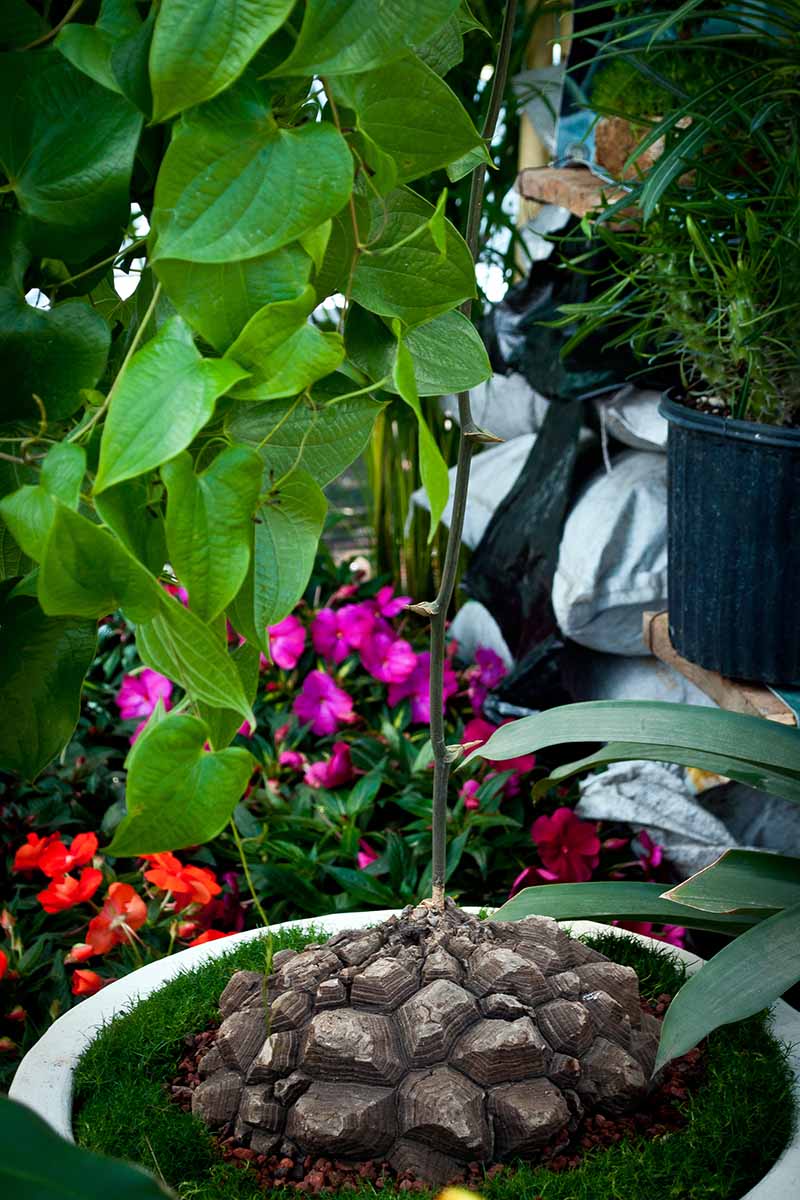
Speaking of the vines, they’ll eventually need something to cling to as they climb.
A thin wooden stake or a spiral houseplant trellis provides that structure without disrupting the aesthetic too much.
Be sure to repot the tortoise plant whenever it outgrows that inch or two of elbow room between the sides of the caudex and the container’s edges.
Where to Buy
A tortoise plant isn’t the most common of specimens, but you can definitely find one if you know where to look.
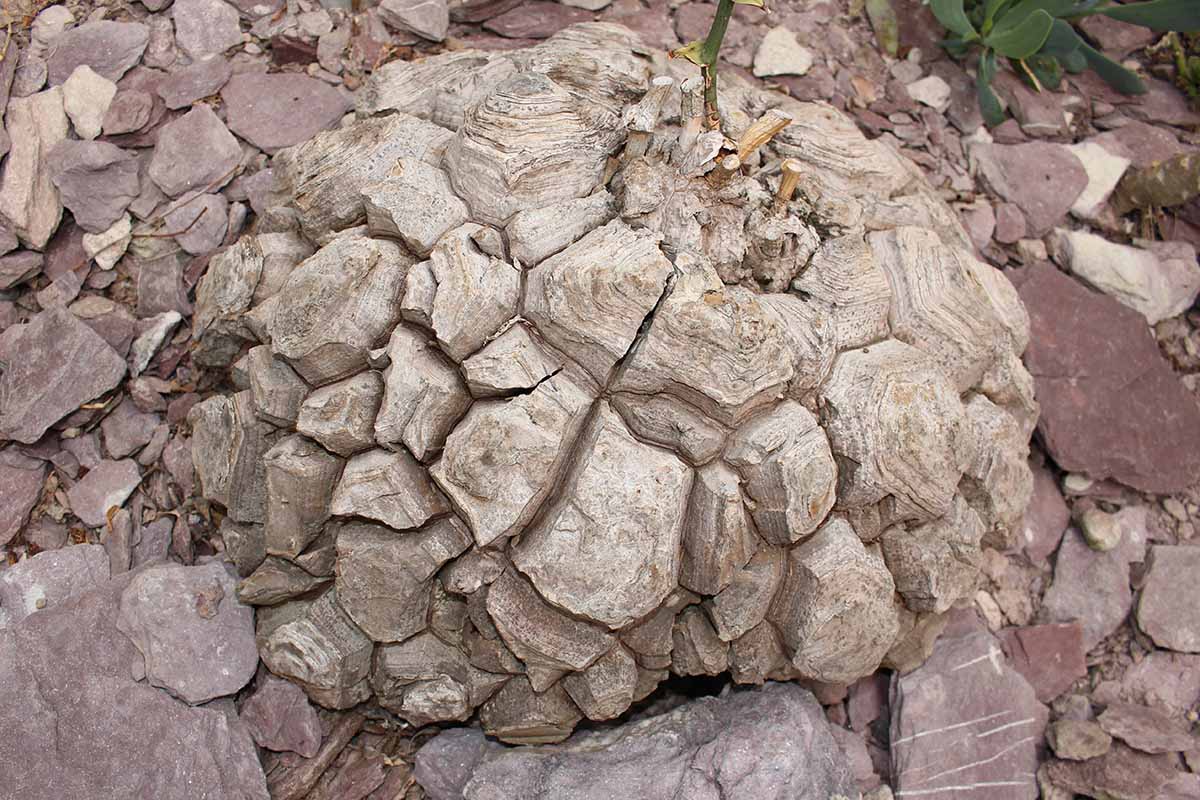
Good starting points for your search include niche plant nurseries, specialty shops, and horticultural trade shows.
Check your network of fellow green thumbs to see if any of them have spare tortoise plant to give, whether in seed or transplant form.
Managing Pests and Disease
Thankfully, indoor gardeners don’t have to deal with as many pest and disease problems as their outdoor counterparts. But there are a few worth looking out for.
Insects
Since insects can vector diseases as they feed, managing them usually results in free disease prevention, on-the-house. Talk about a plus!
Aphids
These translucent, pear-shaped, and soft-bodied insects are small in stature, but large in nuisance-ness. They’re usually one of the first pests that gardeners learn about, and one of the first that they hate.
Using their piercing-sucking mouthparts, aphids will extract the vital fluids from leaves and herbaceous stems, which can cause leaf distortion, chlorosis, and stunted growth overall.
Adding insult to injury, they excrete honeydew as they feed, which can cause black sooty mold to form.
Strong sprays of water can blast pests off the plant, while applications of horticultural oil or insecticidal soap will actually kill them.
Either way, you will want to bring your tortoise plant outside first, lest you soak your floor with water or insect-controlling chemicals.
For some OMRI-listed horticultural oil in ready-to-spray or concentrated form, check out what Monterey has to offer at Arbico Organics.
Learn more about aphids and how to deal with them in our guide.
Mealybugs
Appearing as white cottony clumps on leaves and stems, mealybugs will suck sap out of the plant’s phloem, stunting growth and potentially killing any infested tissue.
Plus, like aphids, they secrete honeydew.
Mealybugs on the vines can be sprayed with insecticidal soap.
You can try this one from Bonide, available in various volumes in spray bottle or concentrate form from Arbico Organics.
Our guide to controlling mealybugs has more information.
Scale
Scale are small, rounded, and flattened insects that come in either armored or soft-bodied forms.
Typically congregating in conspicuous masses on shoots, they continue the theme of sap suction and honeydew secretion, with all the associated symptoms of stunted growth, weakening, and necrosis.
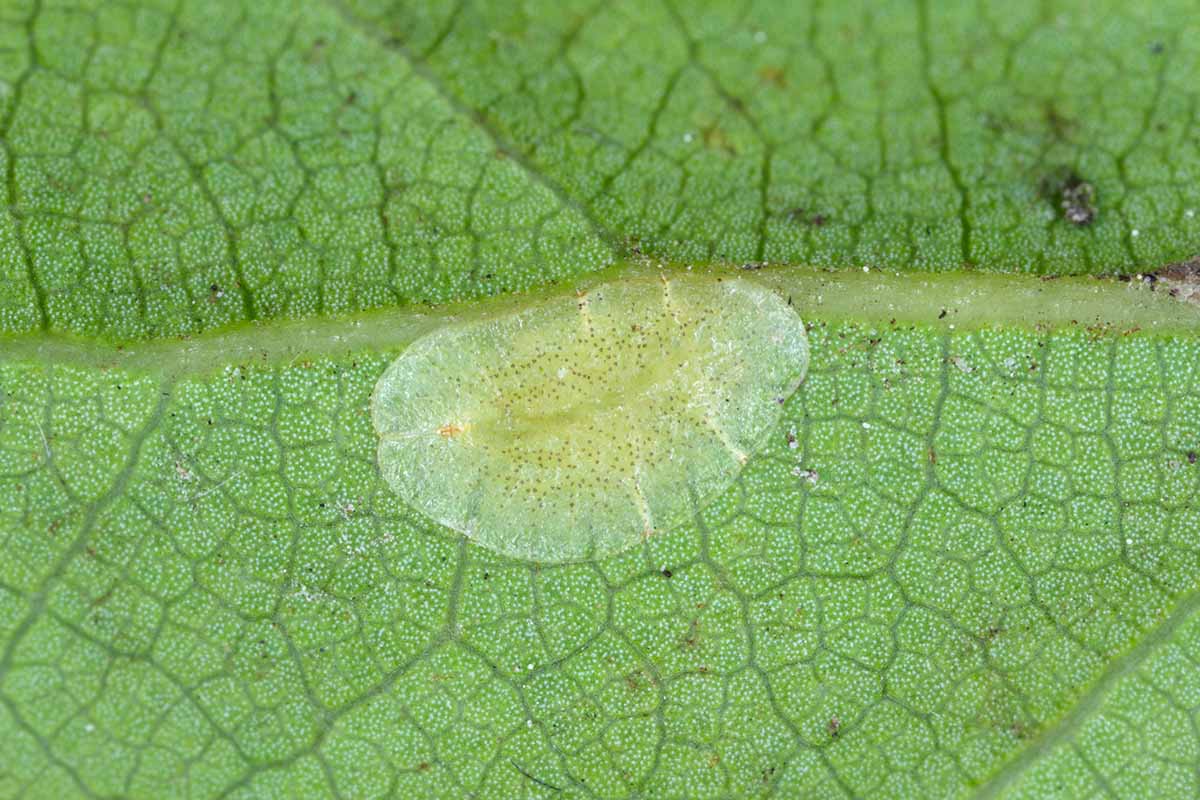
Insecticidal soap can control scale on the shoots, but you can also physically pick them off of plant surfaces with a skinny toothpick or something similar.
Learn more about dealing with scale in our guide.
Root Rot
There aren’t too many diseases that an indoor tortoise plant has to deal with, especially if you keep your home and gardening practices sanitary. But believe it or not, it can actually be easier for a D. elephantipes to develop root rot indoors than growing outdoors in the landscape.
If you grow a tortoise plant outdoors in the right environment, then the high heat will evaporate soil moisture quicker than the typical temperatures of your house.
Houseplant containers are also pretty easy to overwater, especially if you irrigate them with the frequency of a waiter refilling your water glass.
When a tortoise plant’s growing media isn’t allowed to dry between waterings, then the roots probably won’t receive enough oxygen. As a result, the root system becomes necrotic and dies, which spells disaster for the aboveground caudex and vines.
You can prevent this by not overwatering and ensuring the potting medium has sufficient drainage, and you fix it by dealing with those issues as quickly as possible, along with pruning away any rotted roots.
There’s no definitive line for when a plant is officially toast, but its odds of survival are grim when the majority of its root system is rotted away.
Find more tips on preventing root rot here.
Best Uses for Tortoise Plants
D. elephantipes is versatile enough to be both a central specimen or a supporting accent in a houseplant arrangement. But if you ask me, the strength of a tortoise plant lies in its unique appearance.
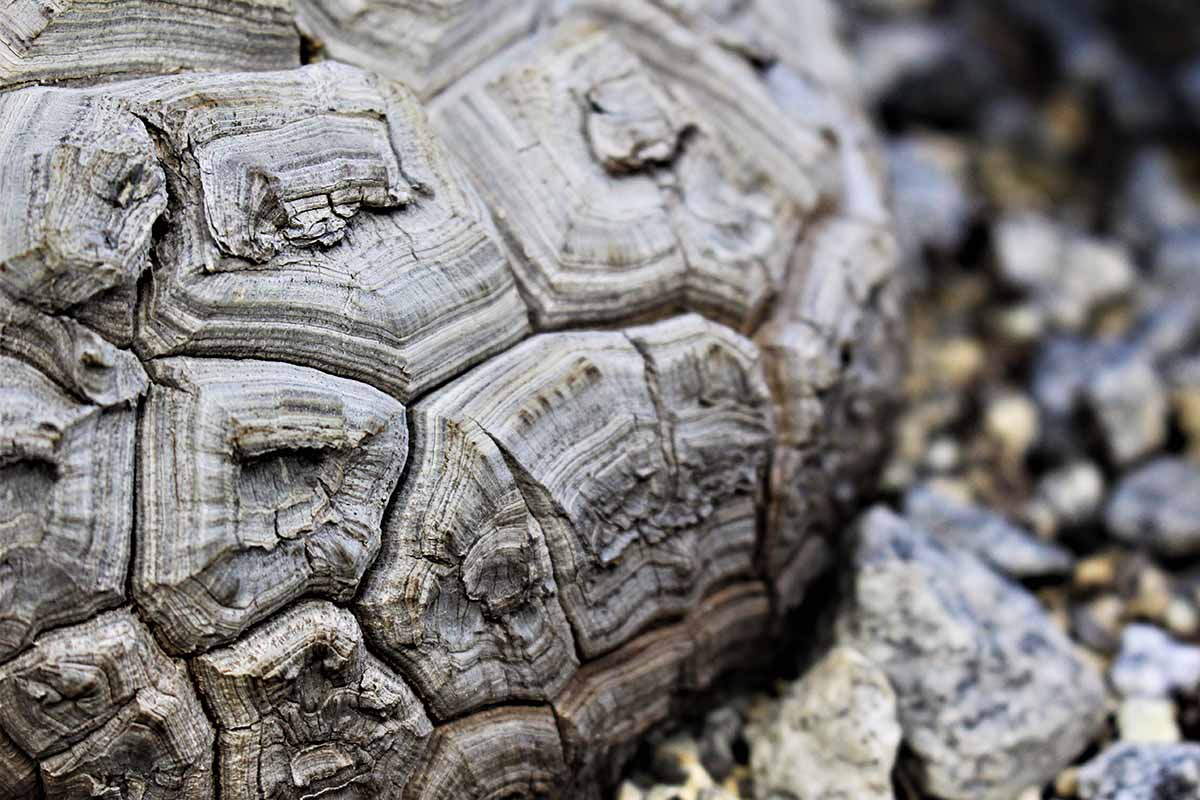
So if it’s placed in a spot where your houseguests can readily look at it, do a double-take, and go “whoa,” then you’ve chosen your placement wisely.
Quick Reference Growing Guide
| Plant Type: | Deciduous flowering perennial vine | Flower/Foliage Color: | White, yellow to green; green |
| Native to: | South Africa | Water Needs: | Low |
| Hardiness (USDA Zone): | 9b-12 | Maintenance: | Moderate |
| Bloom Time/Season: | Fall to winter | Tolerance: | Drought, heat |
| Exposure: | Bright, indirect light | Soil Type: | Cactus and succulent growing medium, fertile sandy loam |
| Time to Maturity: | 10 years | Soil pH: | 5.5-6.5 |
| Spacing: | 1 inch away from container edges | Soil Drainage: | Well-draining |
| Planting Depth: | 1/3 inch (seeds), depth of root system (transplants) | Uses: | Accent, houseplant, specimen |
| Height: | Up to 9 feet | Order: | Dioscoreales |
| Spread: | Up to 7 feet (smaller indoors) | Family: | Dioscoreaceae |
| Growth Rate: | Slow | Genus: | Dioscorea |
| Common Pests and Diseases: | Aphids, mealybugs, scale; root rot | Species: | Elephantipes |
You Gotta Flex the Caudex
What’s the point of having a swollen aboveground stem if you can’t show it off?
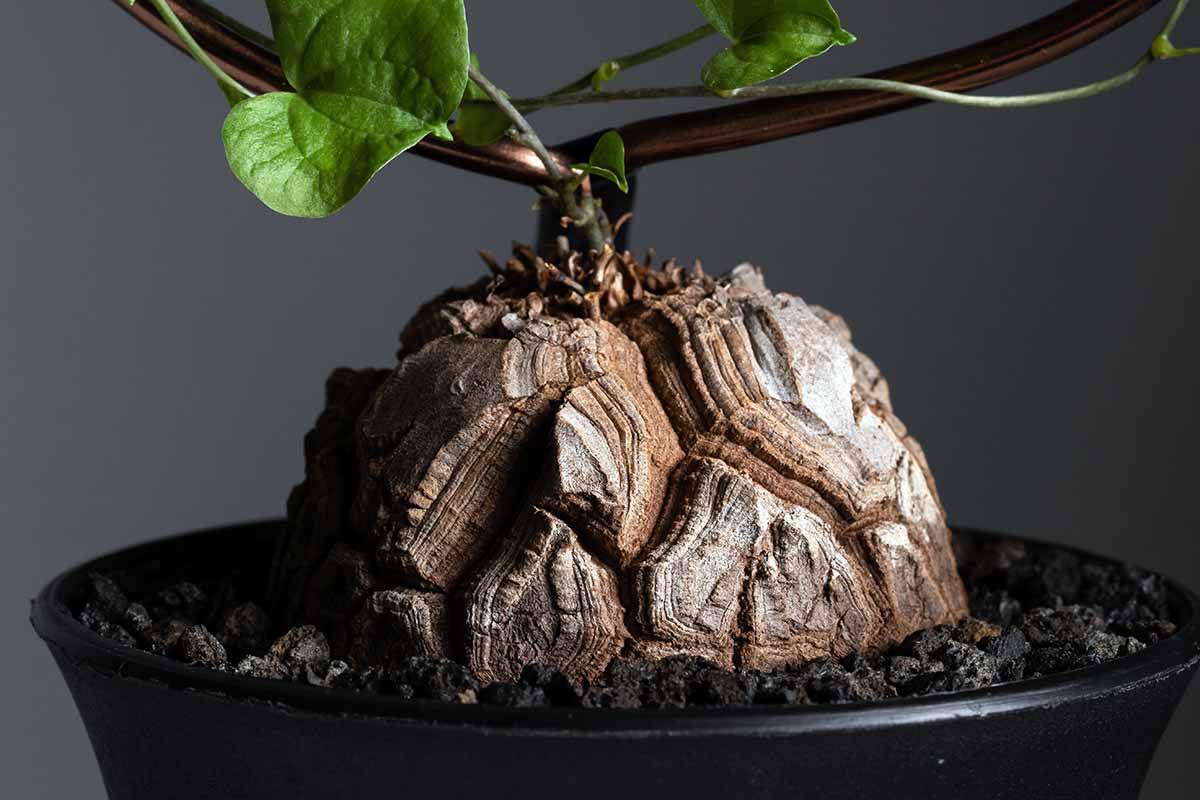
With the proper cultivation practices that you’ve learned in this guide, you’ll have a wonderful tortoise plant that’s fit for flaunting.
Did I miss something that you wanted to know? Do you have experiences of your own to share? Let us know in the comments section below!
Need more animal-themed houseplants? Turn your home into a veritable zoo by reading these guides next:
